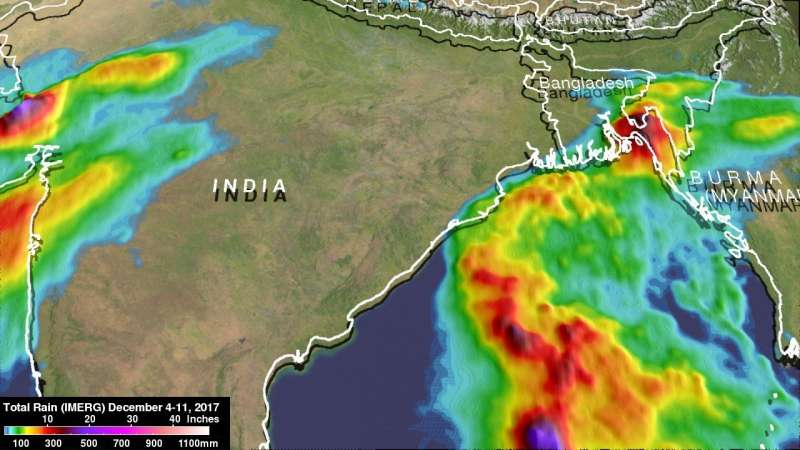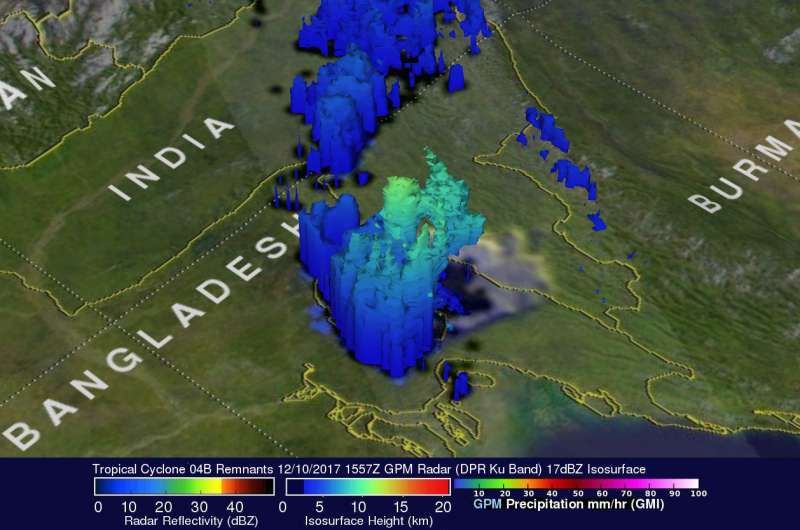NASA analyzes short-lived Bay of Bengal cyclone

NASA analyzed the rainfall generated by short-lived Tropical Cyclone 04B that formed and faded over a day in the Bay of Bengal.
A substantial area of the Northern Indian Ocean was recently covered with cloudiness and rain showers as a large tropical low pressure area moved over the warm waters of the Bay of Bengal. After being closely monitored for over a week, the tropical disturbance intensified briefly to tropical storm force in the northern Bay of Bengal. It was labeled tropical cyclone 04B on December 9, 2017. The weak system produced moderate to heavy rainfall along northeastern India's Bay of Bengal coastline, moved over southern Bangladesh and dissipated over northwestern Burma.
At NASA's Goddard Space Flight Center in Greenbelt, Maryland, a rainfall accumulation analysis was created on 04B. It was derived from NASA's Integrated Multi-satellitE Retrievals data (IMERG).
NASA's GPM or Global Precipitation Measurement mission satellite provides information on precipitation from its orbit in space. GPM is a joint mission between NASA and the Japan Aerospace Exploration Agency or JAXA. GPM also utilizes a constellation of other satellites to provide a global analysis of precipitation that are used in the IMERG calculation.
At NASA Goddard, an animation of IMERG rainfall accumulation total estimates showed the progression of rainfall through the Bay of Bengal for the period from December 4 to 11, 2017. Those IMERG rainfall estimates showed that the heaviest rainfall occurred in the Bay of Bengal well to the east of India's coast. A total of more than 508 mm (20 inches) of rain was analyzed in the Bay of Bengal as the tropical disturbance moved slowly through the area.
The analysis also showed rainfall accumulation caused by tropical cyclone Ockhi.
The GPM core observatory satellite had a good view of tropical cyclone 04B's remnants on Dec. 10 at 10:57 a.m. EST (1557 UTC). Data collected by GPM's Microwave Imager (GMI) and Dual-Frequency Precipitation Radar (DPR) instruments showed than heavy rain was only occurring in a small cluster of storms over southeastern Bangladesh. GPM's radar (DPR Ku band) found rain falling at more than 70 mm (2.75 inches) per hour in one storm.

GPM's radar (DPR Ku band) data were used in a close-up 3-D view of rainfall within the few remnants of tropical cyclone 04B. This view (looking toward the northeast) showed that storm tops were reaching heights greater than 11.5 km (7.1 miles) in a small cluster of energetic storms.
The Joint Typhoon Warning Center issued the final bulletin on Tropical Cyclone 04B on Dec. 9 at 4 a.m. EST (0900 UTC). At that time Tropical cyclone 04B was located near 18.8 degrees north latitude and 86.8 degrees east longitude, about 245 miles south-southwest of Kolkata, India. 04B had maximum sustained winds near 35 knots (40 mph/62 kph) and weakening quickly under vertical wind shear.
Tropical Cyclone 04B dissipated before making landfall.
Provided by NASA's Goddard Space Flight Center





















